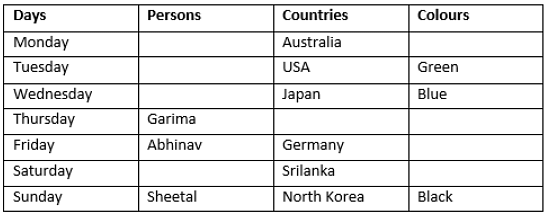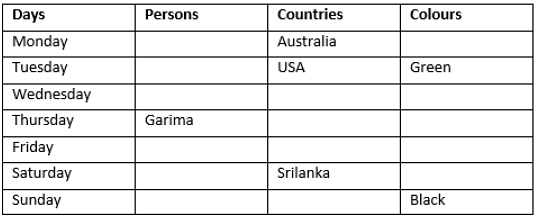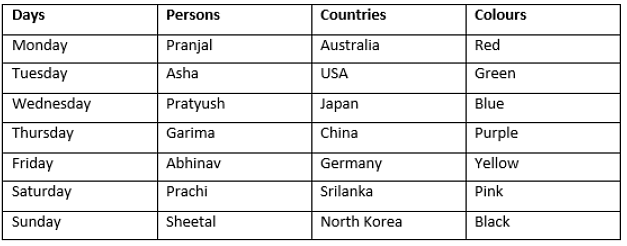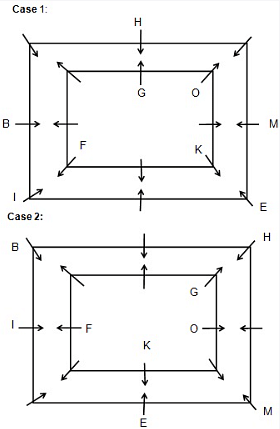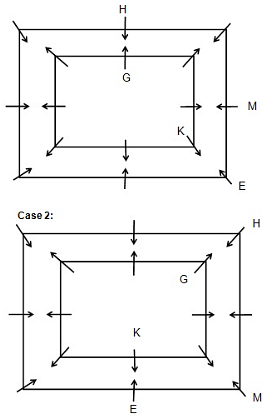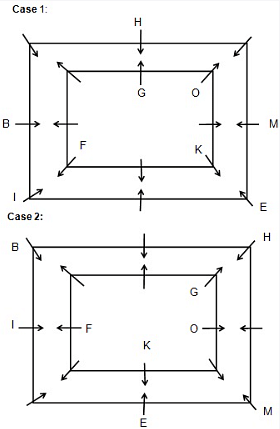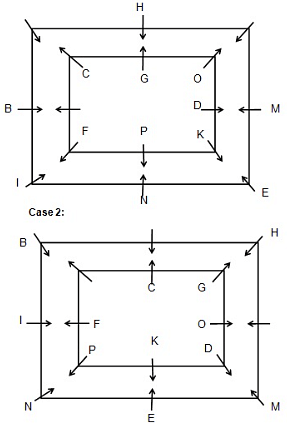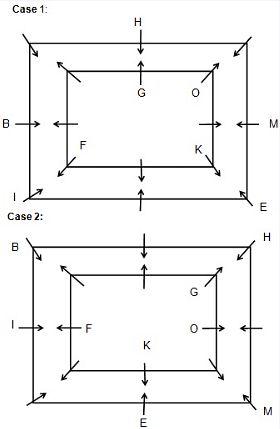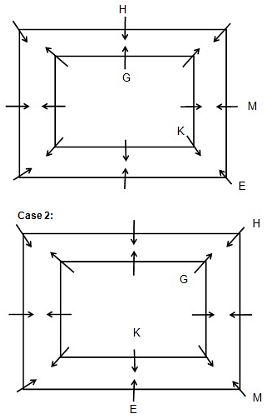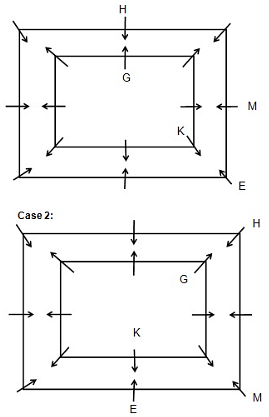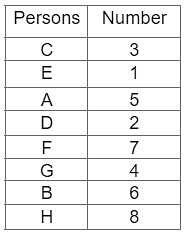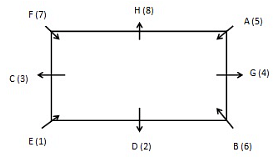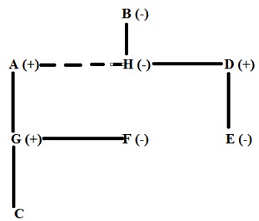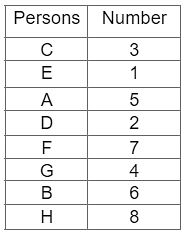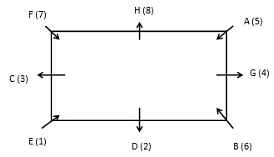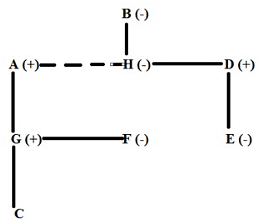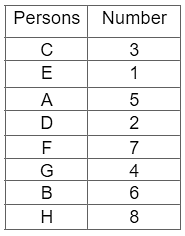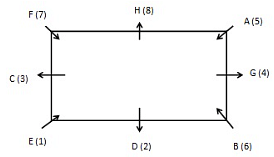IBPS PO Mains Mock Test - 2 - Bank Exams MCQ
30 Questions MCQ Test Mock Tests for Banking Exams 2024 - IBPS PO Mains Mock Test - 2
Study the following information carefully to answer the given questions.
Seven persons viz. Pratyush, Prachi, Pranjal, Garima, Abhinav, Sheetal and Asha visit different countries viz., Australia, Srilanka, Germany, China, USA, Japan and North Korea on different days starting from Monday to Sunday. Also each of the person likes different colours viz. Red, yellow, pink, green, purple, blue and black. Also each of them is of different age. Neither Abhinav nor Sheetal is youngest. The one who visit Germany is sixth youngest. Only three persons visit the countries in between the one who likes green and the one who visits Srilanka. The one who is youngest, visit Australia on Monday. The one who visits USA likes green. Pratyush likes blue. Only three persons are older than Asha. The one who is sixth oldest visits North Korea but not on Friday. Garima visits the country on Thursday and is just older than Abhinav. The one who likes black visits the country after maximum number of Persons. Prachi is older than only two people. The one who visits Srilanka does not like black and does not visit on Tuesday. Pratyush is older than both Pranjal and Sheetal but not the oldest. The one who visits Japan and likes blue, visits it immediately after the one who visit USA. One who likes pink visit immediately after the one who likes yellow but not on Friday. The one who is youngest likes red but not immediately after Abhinav. Asha neither visit Srilanka nor Japan.
Q. Which among the following likes purple colour?
Study the following information carefully to answer the given questions.
Seven persons viz. Pratyush, Prachi, Pranjal, Garima, Abhinav, Sheetal and Asha visit different countries viz., Australia, Srilanka, Germany, China, USA, Japan and North Korea on different days starting from Monday to Sunday. Also each of the person likes different colours viz. Red, yellow, pink, green, purple, blue and black. Also each of them is of different age. Neither Abhinav nor Sheetal is youngest. The one who visit Germany is sixth youngest. Only three persons visit the countries in between the one who likes green and the one who visits Srilanka. The one who is youngest, visit Australia on Monday. The one who visits USA likes green. Pratyush likes blue. Only three persons are older than Asha. The one who is sixth oldest visits North Korea but not on Friday. Garima visits the country on Thursday and is just older than Abhinav. The one who likes black visits the country after maximum number of Persons. Prachi is older than only two people. The one who visits Srilanka does not like black and does not visit on Tuesday. Pratyush is older than both Pranjal and Sheetal but not the oldest. The one who visits Japan and likes blue, visits it immediately after the one who visit USA. One who likes pink visit immediately after the one who likes yellow but not on Friday. The one who is youngest likes red but not immediately after Abhinav. Asha neither visit Srilanka nor Japan.
Q. Which among the following is true regarding Asha?
| 1 Crore+ students have signed up on EduRev. Have you? Download the App |
Study the following information carefully to answer the given questions.
Seven persons viz. Pratyush, Prachi, Pranjal, Garima, Abhinav, Sheetal and Asha visit different countries viz., Australia, Srilanka, Germany, China, USA, Japan and North Korea on different days starting from Monday to Sunday. Also each of the person likes different colours viz. Red, yellow, pink, green, purple, blue and black. Also each of them is of different age. Neither Abhinav nor Sheetal is youngest. The one who visit Germany is sixth youngest. Only three persons visit the countries in between the one who likes green and the one who visits Srilanka. The one who is youngest, visit Australia on Monday. The one who visits USA likes green. Pratyush likes blue. Only three persons are older than Asha. The one who is sixth oldest visits North Korea but not on Friday. Garima visits the country on Thursday and is just older than Abhinav. The one who likes black visits the country after maximum number of Persons. Prachi is older than only two people. The one who visits Srilanka does not like black and does not visit on Tuesday. Pratyush is older than both Pranjal and Sheetal but not the oldest. The one who visits Japan and likes blue, visits it immediately after the one who visit USA. One who likes pink visit immediately after the one who likes yellow but not on Friday. The one who is youngest likes red but not immediately after Abhinav. Asha neither visit Srilanka nor Japan.
Q. Who among the following visit North Korea?
Study the following information carefully to answer the given questions.
Seven persons viz. Pratyush, Prachi, Pranjal, Garima, Abhinav, Sheetal and Asha visit different countries viz., Australia, Srilanka, Germany, China, USA, Japan and North Korea on different days starting from Monday to Sunday. Also each of the person likes different colours viz. Red, yellow, pink, green, purple, blue and black. Also each of them is of different age. Neither Abhinav nor Sheetal is youngest. The one who visit Germany is sixth youngest. Only three persons visit the countries in between the one who likes green and the one who visits Srilanka. The one who is youngest, visit Australia on Monday. The one who visits USA likes green. Pratyush likes blue. Only three persons are older than Asha. The one who is sixth oldest visits North Korea but not on Friday. Garima visits the country on Thursday and is just older than Abhinav. The one who likes black visits the country after maximum number of Persons. Prachi is older than only two people. The one who visits Srilanka does not like black and does not visit on Tuesday. Pratyush is older than both Pranjal and Sheetal but not the oldest. The one who visits Japan and likes blue, visits it immediately after the one who visit USA. One who likes pink visit immediately after the one who likes yellow but not on Friday. The one who is youngest likes red but not immediately after Abhinav. Asha neither visit Srilanka nor Japan.
Q. Prachi visit the country on which of the following day?
Study the following information carefully to answer the given questions.
Seven persons viz. Pratyush, Prachi, Pranjal, Garima, Abhinav, Sheetal and Asha visit different countries viz., Australia, Srilanka, Germany, China, USA, Japan and North Korea on different days starting from Monday to Sunday. Also each of the person likes different colours viz. Red, yellow, pink, green, purple, blue and black. Also each of them is of different age. Neither Abhinav nor Sheetal is youngest. The one who visit Germany is sixth youngest. Only three persons visit the countries in between the one who likes green and the one who visits Srilanka. The one who is youngest, visit Australia on Monday. The one who visits USA likes green. Pratyush likes blue. Only three persons are older than Asha. The one who is sixth oldest visits North Korea but not on Friday. Garima visits the country on Thursday and is just older than Abhinav. The one who likes black visits the country after maximum number of Persons. Prachi is older than only two people. The one who visits Srilanka does not like black and does not visit on Tuesday. Pratyush is older than both Pranjal and Sheetal but not the oldest. The one who visits Japan and likes blue, visits it immediately after the one who visit USA. One who likes pink visit immediately after the one who likes yellow but not on Friday. The one who is youngest likes red but not immediately after Abhinav. Asha neither visit Srilanka nor Japan.
Q. Who among the following is second oldest?
Direction: Read the following information carefully and answer the question given below-
There are some persons who are sitting in a row and facing north. The number of persons who sit on the left side of E is one less than the number of persons who sit on the right side of E. There are more than two persons between Q and T who sits to the left of W. Q sits on the left side of X. F does not sit on the extreme ends. There are four persons between P and V. There are two persons between R and W. Neither N nor M is the neighbor of X. There are four persons between W and Z who do not sit to the left of E. There are only two persons who sit to the left of X. There is one person between E and P. E is not the immediate neighbor of X. P is the immediate neighbor of X.
Q. How many persons sit between X and Z?
Direction: Read the following information carefully and answer the question given below-
There are some persons who are sitting in a row and facing north. The number of persons who sit on the left side of E is one less than the number of persons who sit on the right side of E. There are more than two persons between Q and T who sits to the left of W. Q sits on the left side of X. F does not sit on the extreme ends. There are four persons between P and V. There are two persons between R and W. Neither N nor M is the neighbor of X. There are four persons between W and Z who do not sit to the left of E. There are only two persons who sit to the left of X. There is one person between E and P. E is not the immediate neighbor of X. P is the immediate neighbor of X.
Q. The position of how many persons are not known?
Direction: Read the following information carefully and answer the question given below-
There are some persons who are sitting in a row and facing north. The number of persons who sit on the left side of E is one less than the number of persons who sit on the right side of E. There are more than two persons between Q and T who sits to the left of W. Q sits on the left side of X. F does not sit on the extreme ends. There are four persons between P and V. There are two persons between R and W. Neither N nor M is the neighbor of X. There are four persons between W and Z who do not sit to the left of E. There are only two persons who sit to the left of X. There is one person between E and P. E is not the immediate neighbor of X. P is the immediate neighbor of X.
Q. Four of the following are alike in a certain way and hence form a group. Which of the following does not belong to that group?
Direction: Read the following information carefully and answer the question given below-
There are some persons who are sitting in a row and facing north. The number of persons who sit on the left side of E is one less than the number of persons who sit on the right side of E. There are more than two persons between Q and T who sits to the left of W. Q sits on the left side of X. F does not sit on the extreme ends. There are four persons between P and V. There are two persons between R and W. Neither N nor M is the neighbor of X. There are four persons between W and Z who do not sit to the left of E. There are only two persons who sit to the left of X. There is one person between E and P. E is not the immediate neighbor of X. P is the immediate neighbor of X.
Q. How many persons sit in the row?
Direction: Read the following information carefully and answer the question given below-
There are some persons who are sitting in a row and facing north. The number of persons who sit on the left side of E is one less than the number of persons who sit on the right side of E. There are more than two persons between Q and T who sits to the left of W. Q sits on the left side of X. F does not sit on the extreme ends. There are four persons between P and V. There are two persons between R and W. Neither N nor M is the neighbor of X. There are four persons between W and Z who do not sit to the left of E. There are only two persons who sit to the left of X. There is one person between E and P. E is not the immediate neighbor of X. P is the immediate neighbor of X.
Q. How many persons sit between Q and W?
Study the following information and answer the given questions.
Ten people live in three buildings namely X, Y and Z. Building X is immediate left of building Y whereas building Z is to the second right of building X. Not more than four people live in a building and immediate above or below implies that the person is not in the same building. O does not live in building Y but lives at floor number 5. P lives in that floor which is the sum of the floor number in which Q and O lives. The sum of floor number in which R and M live is 3 and both live in different building. The sum of the number of the floor in which M and S live is equal to the floor number in which N live. M lives in the even numbered floor. Equal numbers of floors are there below the floor in which T lives and above the floor in which V lives. As many floors are there below the floor in which M lives as it is above the floor in which N lives. There are four floors above the floor in which O lives. There are two floors between V and T in the same building. U lives on that floor number which is immediately below the floor number in which S lives. Only two people live in building Z. O and U live in same building. Q lives in building Y and lives at the topmost floor. M and N live in same building but they do not live in building X. Q lives immediately two floors above the floor in which O lives.
Q. What is the sum of floors of R and O?
Study the following information and answer the given questions.
Ten people live in three buildings namely X, Y and Z. Building X is immediate left of building Y whereas building Z is to the second right of building X. Not more than four people live in a building and immediate above or below implies that the person is not in the same building. O does not live in building Y but lives at floor number 5. P lives in that floor which is the sum of the floor number in which Q and O lives. The sum of floor number in which R and M live is 3 and both live in different building. The sum of the number of the floor in which M and S live is equal to the floor number in which N live. M lives in the even numbered floor. Equal numbers of floors are there below the floor in which T lives and above the floor in which V lives. As many floors are there below the floor in which M lives as it is above the floor in which N lives. There are four floors above the floor in which O lives. There are two floors between V and T in the same building. U lives on that floor number which is immediately below the floor number in which S lives. Only two people live in building Z. O and U live in same building. Q lives in building Y and lives at the topmost floor. M and N live in same building but they do not live in building X. Q lives immediately two floors above the floor in which O lives.
Q. Who among the following lives on even numbered floor?
Study the following information and answer the given questions.
Ten people live in three buildings namely X, Y and Z. Building X is immediate left of building Y whereas building Z is to the second right of building X. Not more than four people live in a building and immediate above or below implies that the person is not in the same building. O does not live in building Y but lives at floor number 5. P lives in that floor which is the sum of the floor number in which Q and O lives. The sum of floor number in which R and M live is 3 and both live in different building. The sum of the number of the floor in which M and S live is equal to the floor number in which N live. M lives in the even numbered floor. Equal numbers of floors are there below the floor in which T lives and above the floor in which V lives. As many floors are there below the floor in which M lives as it is above the floor in which N lives. There are four floors above the floor in which O lives. There are two floors between V and T in the same building. U lives on that floor number which is immediately below the floor number in which S lives. Only two people live in building Z. O and U live in same building. Q lives in building Y and lives at the topmost floor. M and N live in same building but they do not live in building X. Q lives immediately two floors above the floor in which O lives.
Q. Who among the following are immediate neighbours in a building?
Study the following information and answer the given questions.
Ten people live in three buildings namely X, Y and Z. Building X is immediate left of building Y whereas building Z is to the second right of building X. Not more than four people live in a building and immediate above or below implies that the person is not in the same building. O does not live in building Y but lives at floor number 5. P lives in that floor which is the sum of the floor number in which Q and O lives. The sum of floor number in which R and M live is 3 and both live in different building. The sum of the number of the floor in which M and S live is equal to the floor number in which N live. M lives in the even numbered floor. Equal numbers of floors are there below the floor in which T lives and above the floor in which V lives. As many floors are there below the floor in which M lives as it is above the floor in which N lives. There are four floors above the floor in which O lives. There are two floors between V and T in the same building. U lives on that floor number which is immediately below the floor number in which S lives. Only two people live in building Z. O and U live in same building. Q lives in building Y and lives at the topmost floor. M and N live in same building but they do not live in building X. Q lives immediately two floors above the floor in which O lives.
Q. How many floors are there between V and P?
Study the following information and answer the given questions.
Ten people live in three buildings namely X, Y and Z. Building X is immediate left of building Y whereas building Z is to the second right of building X. Not more than four people live in a building and immediate above or below implies that the person is not in the same building. O does not live in building Y but lives at floor number 5. P lives in that floor which is the sum of the floor number in which Q and O lives. The sum of floor number in which R and M live is 3 and both live in different building. The sum of the number of the floor in which M and S live is equal to the floor number in which N live. M lives in the even numbered floor. Equal numbers of floors are there below the floor in which T lives and above the floor in which V lives. As many floors are there below the floor in which M lives as it is above the floor in which N lives. There are four floors above the floor in which O lives. There are two floors between V and T in the same building. U lives on that floor number which is immediately below the floor number in which S lives. Only two people live in building Z. O and U live in same building. Q lives in building Y and lives at the topmost floor. M and N live in same building but they do not live in building X. Q lives immediately two floors above the floor in which O lives.
Q. Who among the following lives in the same building?
Direction: Read the following information carefully and answer the question given below-
Sixteen students A, B, C, D, E, F, G, H, I, J, K, L, M, N, O and P were playing in a square-shaped playground. They were seated along two concentric square shaped playgrounds such that the inner playground was inside the outer playground. Eight of them were seated around the outer playground facing the center and eight were seated around the inner playground facing outside the center. Eight were seated along the eight sides of the two squares and eight were at the corner of the two squares. Two persons were said to be facing each other when they were on the same side of the playground and a person was said to be seated in between any two persons when they were on the same playground.
G was third to the left of K who was facing E. G was seated along the inner playground. G faced H who was second to the right of M. I faced F whose neighbor faced the person who was second to the right of B. E and I were seated at a gap of one person. M’s neighbor faced O who was at a gap of two persons from P who faced N. B’s neighbor faced C who was third to the left of D. A was second to the right of L. N was seated at one of the corners.
Q. In which of the following groups was the 1st person seated exactly in between the 2nd and the 3rd person?
Direction: Read the following information carefully and answer the question given below-
Sixteen students A, B, C, D, E, F, G, H, I, J, K, L, M, N, O and P were playing in a square-shaped playground. They were seated along two concentric square shaped playgrounds such that the inner playground was inside the outer playground. Eight of them were seated around the outer playground facing the center and eight were seated around the inner playground facing outside the center. Eight were seated along the eight sides of the two squares and eight were at the corner of the two squares. Two persons were said to be facing each other when they were on the same side of the playground and a person was said to be seated in between any two persons when they were on the same playground.
G was third to the left of K who was facing E. G was seated along the inner playground. G faced H who was second to the right of M. I faced F whose neighbor faced the person who was second to the right of B. E and I were seated at a gap of one person. M’s neighbor faced O who was at a gap of two persons from P who faced N. B’s neighbor faced C who was third to the left of D. A was second to the right of L. N was seated at one of the corners.
Q. Four of the following are alike and hence form a group. Which of the following does not belong to that group?
Direction: Read the following information carefully and answer the question given below-
Sixteen students A, B, C, D, E, F, G, H, I, J, K, L, M, N, O and P were playing in a square-shaped playground. They were seated along two concentric square shaped playgrounds such that the inner playground was inside the outer playground. Eight of them were seated around the outer playground facing the center and eight were seated around the inner playground facing outside the center. Eight were seated along the eight sides of the two squares and eight were at the corner of the two squares. Two persons were said to be facing each other when they were on the same side of the playground and a person was said to be seated in between any two persons when they were on the same playground.
G was third to the left of K who was facing E. G was seated along the inner playground. G faced H who was second to the right of M. I faced F whose neighbor faced the person who was second to the right of B. E and I were seated at a gap of one person. M’s neighbor faced O who was at a gap of two persons from P who faced N. B’s neighbor faced C who was third to the left of D. A was second to the right of L. N was seated at one of the corners.
Q. G is facing to which person?
Direction: Read the following information carefully and answer the question given below-
Sixteen students A, B, C, D, E, F, G, H, I, J, K, L, M, N, O and P were playing in a square-shaped playground. They were seated along two concentric square shaped playgrounds such that the inner playground was inside the outer playground. Eight of them were seated around the outer playground facing the center and eight were seated around the inner playground facing outside the center. Eight were seated along the eight sides of the two squares and eight were at the corner of the two squares. Two persons were said to be facing each other when they were on the same side of the playground and a person was said to be seated in between any two persons when they were on the same playground.
G was third to the left of K who was facing E. G was seated along the inner playground. G faced H who was second to the right of M. I faced F whose neighbor faced the person who was second to the right of B. E and I were seated at a gap of one person. M’s neighbor faced O who was at a gap of two persons from P who faced N. B’s neighbor faced C who was third to the left of D. A was second to the right of L. N was seated at one of the corners.
Q. If in a certain manner J is related to A and K is related to N, then in the same manner who will be related to P?
Direction: Read the following information carefully and answer the question given below-
Sixteen students A, B, C, D, E, F, G, H, I, J, K, L, M, N, O and P were playing in a square-shaped playground. They were seated along two concentric square shaped playgrounds such that the inner playground was inside the outer playground. Eight of them were seated around the outer playground facing the center and eight were seated around the inner playground facing outside the center. Eight were seated along the eight sides of the two squares and eight were at the corner of the two squares. Two persons were said to be facing each other when they were on the same side of the playground and a person was said to be seated in between any two persons when they were on the same playground.
G was third to the left of K who was facing E. G was seated along the inner playground. G faced H who was second to the right of M. I faced F whose neighbor faced the person who was second to the right of B. E and I were seated at a gap of one person. M’s neighbor faced O who was at a gap of two persons from P who faced N. B’s neighbor faced C who was third to the left of D. A was second to the right of L. N was seated at one of the corners.
Q. Who will be sitting second to the right of A?
Study the following information and answer the given questions. All the parameters are given in metres.
A@B means A is North of B
A#B means A is South of B
A$B means A is west of B
A%B means A is East of B
There are three buses travelling from X to Z.
Bus 1: X30%Y, P12$Y, Q13#P, R14%Q, R13@S, T 15#S, U 28%T
Bus 2: X15@I, Z 15#I, U 11#Z
Bus 3: L 7%Z, K 6#L, J 5%K, O 11$N, O 6@J, N 15#M, M 8%W, V 17%X, V 15@W
Q. What is the distance between Y and R?
Study the following information and answer the given questions. All the parameters are given in metres.
A@B means A is North of B
A#B means A is South of B
A$B means A is west of B
A%B means A is East of B
There are three buses travelling from X to Z.
Bus 1: X30%Y, P12$Y, Q13#P, R14%Q, R13@S, T 15#S, U 28%T
Bus 2: X15@I, Z 15#I, U 11#Z
Bus 3: L 7%Z, K 6#L, J 5%K, O 11$N, O 6@J, N 15#M, M 8%W, V 17%X, V 15@W
Q. What is the minimum distance between V and Z?
Direction: Read the following information carefully and answer the question given below-
A, B, C, D, E, F, G and H are sitting around a square table in such a way that four of them who sits at the corner are facing towards the center and other four who sits in the middle of the table are facing outside the center. Each person has a different favorite number viz. 1, 2, 3, 4, 5, 6, 7 and 8, but not necessarily in the same order. Each of them scored different marks in the exam.
D’s daughter favorite number is 1. Only one person is sitting between A and F. H’s brother D, sits on the immediate left of his mother whose favorite number is 6. A is the father of G and only one person sits between H’s mother and E. D scored the same marks as the average of the marks scored by A and B where A scored more marks than B. E sits on the immediate right of the person whose favorite number is 2. No female is an immediate neighbor of B, who sits at the corner of the table. D’s daughter sits second to the right of F and on the immediate left of that person whose favorite number is 3. Both E and F scored fewer marks than C but more than G and the marks scored by G is not the least. B sits second to the left of H’s husband whose favorite number is neither 4 nor 7. F, who is the sister of G, her favorite number is 7 and is not an immediate neighbor of H’s husband. Only one person sits between H and G. A scored fewer marks than E. Marks scored by H are the least. G sits second to the right of the person whose favorite number is 8. G is the father of C and is not an immediate neighbor of E. A is married to H and average marks scored by A and B is less than G.
Q. What is the sum of a favorite number of F and B?
Direction: Read the following information carefully and answer the question given below-
A, B, C, D, E, F, G and H are sitting around a square table in such a way that four of them who sits at the corner are facing towards the center and other four who sits in the middle of the table are facing outside the center. Each person has a different favorite number viz. 1, 2, 3, 4, 5, 6, 7 and 8, but not necessarily in the same order. Each of them scored different marks in the exam.
D’s daughter favorite number is 1. Only one person is sitting between A and F. H’s brother D, sits on the immediate left of his mother whose favorite number is 6. A is the father of G and only one person sits between H’s mother and E. D scored the same marks as the average of the marks scored by A and B where A scored more marks than B. E sits on the immediate right of the person whose favorite number is 2. No female is an immediate neighbor of B, who sits at the corner of the table. D’s daughter sits second to the right of F and on the immediate left of that person whose favorite number is 3. Both E and F scored fewer marks than C but more than G and the marks scored by G is not the least. B sits second to the left of H’s husband whose favorite number is neither 4 nor 7. F, who is the sister of G, her favorite number is 7 and is not an immediate neighbor of H’s husband. Only one person sits between H and G. A scored fewer marks than E. Marks scored by H are the least. G sits second to the right of the person whose favorite number is 8. G is the father of C and is not an immediate neighbor of E. A is married to H and average marks scored by A and B is less than G.
Q. Which of the following statement is true?
Direction: Read the following information carefully and answer the question given below-
A, B, C, D, E, F, G and H are sitting around a square table in such a way that four of them who sits at the corner are facing towards the center and other four who sits in the middle of the table are facing outside the center. Each person has a different favorite number viz. 1, 2, 3, 4, 5, 6, 7 and 8, but not necessarily in the same order. Each of them scored different marks in the exam.
D’s daughter favorite number is 1. Only one person is sitting between A and F. H’s brother D, sits on the immediate left of his mother whose favorite number is 6. A is the father of G and only one person sits between H’s mother and E. D scored the same marks as the average of the marks scored by A and B where A scored more marks than B. E sits on the immediate right of the person whose favorite number is 2. No female is an immediate neighbor of B, who sits at the corner of the table. D’s daughter sits second to the right of F and on the immediate left of that person whose favorite number is 3. Both E and F scored fewer marks than C but more than G and the marks scored by G is not the least. B sits second to the left of H’s husband whose favorite number is neither 4 nor 7. F, who is the sister of G, her favorite number is 7 and is not an immediate neighbor of H’s husband. Only one person sits between H and G. A scored fewer marks than E. Marks scored by H are the least. G sits second to the right of the person whose favorite number is 8. G is the father of C and is not an immediate neighbor of E. A is married to H and average marks scored by A and B is less than G.
Q. Who is sitting second to the right of A?
Direction: Read the following information carefully and answer the question given below-
A, B, C, D, E, F, G and H are sitting around a square table in such a way that four of them who sits at the corner are facing towards the center and other four who sits in the middle of the table are facing outside the center. Each person has a different favorite number viz. 1, 2, 3, 4, 5, 6, 7 and 8, but not necessarily in the same order. Each of them scored different marks in the exam.
D’s daughter favorite number is 1. Only one person is sitting between A and F. H’s brother D, sits on the immediate left of his mother whose favorite number is 6. A is the father of G and only one person sits between H’s mother and E. D scored the same marks as the average of the marks scored by A and B where A scored more marks than B. E sits on the immediate right of the person whose favorite number is 2. No female is an immediate neighbor of B, who sits at the corner of the table. D’s daughter sits second to the right of F and on the immediate left of that person whose favorite number is 3. Both E and F scored fewer marks than C but more than G and the marks scored by G is not the least. B sits second to the left of H’s husband whose favorite number is neither 4 nor 7. F, who is the sister of G, her favorite number is 7 and is not an immediate neighbor of H’s husband. Only one person sits between H and G. A scored fewer marks than E. Marks scored by H are the least. G sits second to the right of the person whose favorite number is 8. G is the father of C and is not an immediate neighbor of E. A is married to H and average marks scored by A and B is less than G.
Q. Who among the following scored the highest marks?
Direction: Read the following information carefully and answer the question given below-
A, B, C, D, E, F, G and H are sitting around a square table in such a way that four of them who sits at the corner are facing towards the center and other four who sits in the middle of the table are facing outside the center. Each person has a different favorite number viz. 1, 2, 3, 4, 5, 6, 7 and 8, but not necessarily in the same order. Each of them scored different marks in the exam.
D’s daughter favorite number is 1. Only one person is sitting between A and F. H’s brother D, sits on the immediate left of his mother whose favorite number is 6. A is the father of G and only one person sits between H’s mother and E. D scored the same marks as the average of the marks scored by A and B where A scored more marks than B. E sits on the immediate right of the person whose favorite number is 2. No female is an immediate neighbor of B, who sits at the corner of the table. D’s daughter sits second to the right of F and on the immediate left of that person whose favorite number is 3. Both E and F scored fewer marks than C but more than G and the marks scored by G is not the least. B sits second to the left of H’s husband whose favorite number is neither 4 nor 7. F, who is the sister of G, her favorite number is 7 and is not an immediate neighbor of H’s husband. Only one person sits between H and G. A scored fewer marks than E. Marks scored by H are the least. G sits second to the right of the person whose favorite number is 8. G is the father of C and is not an immediate neighbor of E. A is married to H and average marks scored by A and B is less than G.
Q. How is B related to F?
Study the following information carefully and answer the questions
The following words are coded in this manner:
‘Preparing for journey’ as ‘6!I, 0$F, 4#N’
‘Cooking tasty food’ as ‘4^I, 2+S, 8$O’
‘Party for ___(a)___ as ’2!R, 0$F, 4%E ’
‘However meeting goes’ as ‘4@V, __(b)__, 8&O’
Q. What will come in the blank ‘(a)’?
Study the following information carefully and answer the questions
The following words are coded in this manner:
‘Preparing for journey’ as ‘6!I, 0$F, 4#N’
‘Cooking tasty food’ as ‘4^I, 2+S, 8$O’
‘Party for ___(a)___ as ’2!R, 0$F, 4%E ’
‘However meeting goes’ as ‘4@V, __(b)__, 8&O’
Q. What will be the code for "honest"?
Study the following information carefully and answer the questions
The following words are coded in this manner:
‘Preparing for journey’ as ‘6!I, 0$F, 4#N’
‘Cooking tasty food’ as ‘4^I, 2+S, 8$O’
‘Party for ___(a)___ as ’2!R, 0$F, 4%E ’
‘However meeting goes’ as ‘4@V, __(b)__, 8&O’
Q. What will come in the blank ‘(b)’?
|
160 tests
|






